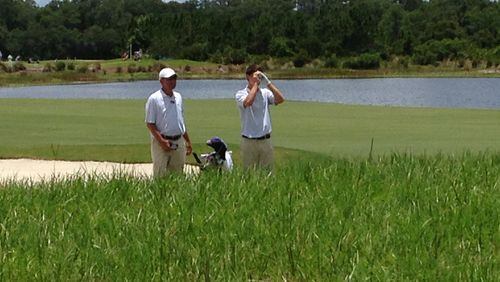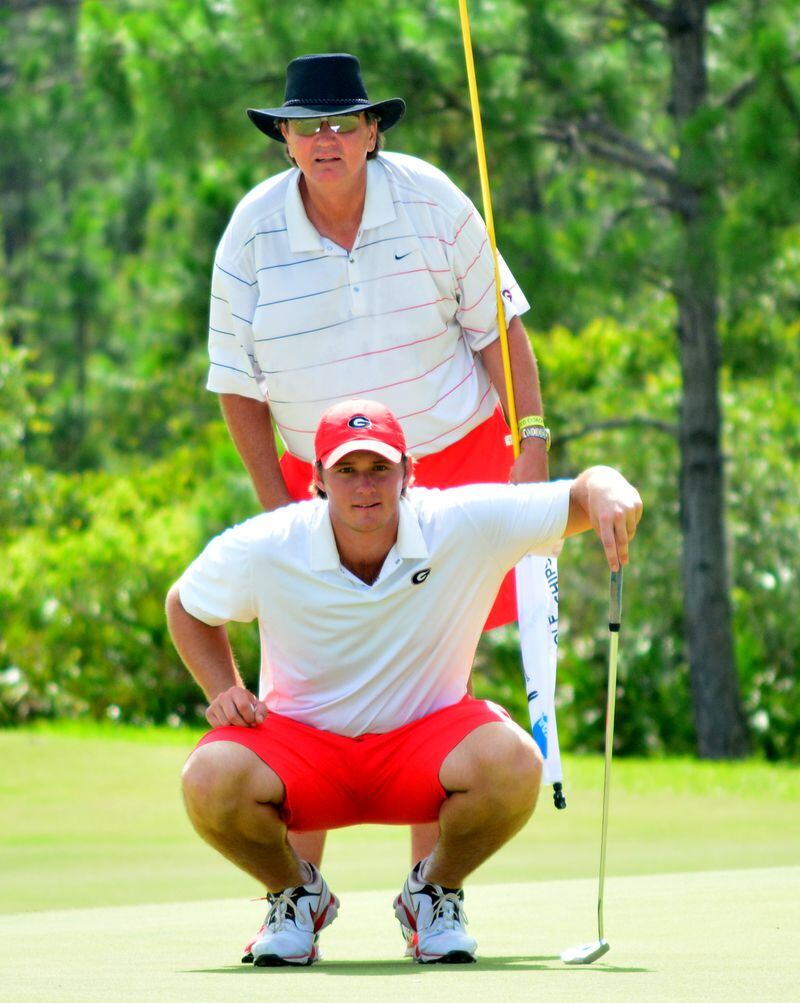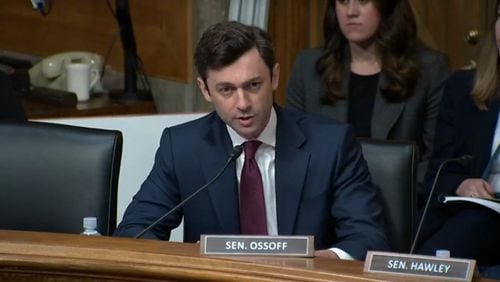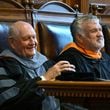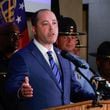BRADENTON, Fla. - To watch Georgia Tech golf coach Bruce Heppler and Georgia counterpart Chris Haack do their work at the NCAA championships is to witness a difference in managerial styles.
At the Concession Golf Club, where stroke play concludes Monday with the fourth round, Heppler and assistant coach Brennan Webb have stationed themselves on the par-3 and par-5 holes. They interact with all five players, text back and forth with each other and occasionally meet up on the course.
It’s a considerable departure from their usual hands-off approach, a concession (so to speak) to the highly penalizing layout of the course, where landing a ball on one spot on the green compared to another spot five feet away can mean the difference between par and double bogey. Heppler and Webb did the same at the NCAA regional tournament at the Farms Golf Club in Rancho Santa Fe, Calif.
“I’ve had more input than I’ve had at this tournament, the last two, than maybe the last five years,” Heppler said, “because I’m big on self-reliance, and you go figure out yourself how to get it done. (At Concession), there’s just too much – the line is too fine here. The same was true in San Diego (at the Farms).”
Haack and assistant coach Jim Douglas, meanwhile, have walked all three rounds with just two players, Haack with Sepp Straka and Douglas with Lee McCoy. In NCAA tournament play, where coaches are not allowed to ride golf carts, that’s Haack and Douglas’ norm. The Bulldogs’ other three players –to Zach Healy, Mookie DeMoss and Greyson Sigg – have been left to themselves.
“I usually like to keep the same guy,” Haack said. “When you’re talking with somebody, you know how their game’s playing. You know what they’re doing. To try to jump around, you don’t know what everybody’s doing.”
Heppler isn’t averse to sticking with one player. He had Webb walk the entire round with sophomore Vince Whaley throughout the spring season.
“He’s so inexperienced, we just gave him a caddy,” Heppler said.
At the NCAA championship, after a shaky start in the first round, Heppler, Webb and Whaley decided mid-round that it was time to take the training wheels off.
“You just let him go and let him feel like he’s as good as anybody else,” Heppler said. “He doesn’t need his hand held.”
Whaley was 7-over after the first round and then 5-under for the next two rounds. He led the tournament in birdies with 15 after three rounds.
As senior Ollie Schniederjans put it, “I think Webb’s had a great impact on Vince, and now he’s letting him fly.”
A benefit of the change in coaching strategy has been that Whaley’s teammates can take advantage of Webb’s considerable knowledge of the Concession layout. None of the Tech players had played it prior to the tournament. As a web.com tour player and later as an assistant at South Florida, Webb has played the course about 25 times.
Webb has stayed at the par-5 holes, meeting players in the fairway after their tee shots, talking them through their second shots and advising on the second shot. He has sometimes walked them to the green to help read putts, then walked back down the fairway to meet the next player coming through.
Heppler has stationed himself at the tees of the par-3 holes. As each player goes through, Heppler can relay what clubs his teammates played at the hole and how they felt the wind impacted the holes. It perhaps befits a team representing a technical institute that its players are using their coaches as resources for data.
“You kind of see how the ball flies and how the wind affects it and whether they misjudged the yardage or not, so you can kind of get a bunch of guinea pigs before you get to the tee,” Schniederjans said.
Early in the fourth round, Tech was the third best team on the par-5's and the seventh best team on the par-3's through three-plus rounds. They were 26th, though, on the par-4's.
It would be easy to conclude that Haack has been a huge help for Straka. The junior from Valdosta had struggled in his past four events, finishing a combined 40-over par and averaging a 48th-place finish. That followed back to back top-10 finishes at a combined 6-under par.
At the NCAA tournament, Straka was tied for 17th through three rounds at 6-over par.
Sunday, on the fairway of the par-4 ninth hole, Haack pointed out Spanish moss hanging high from trees along the fairway. He was showing it to Straka as a gauge on the direction of the swirling winds. Straka stuck his iron to about 10 feet from the pin, then read his birdie putt with Haack peering over his shoulder. He bent it in for a birdie.
“It’s good just having somebody around you that you’re comfortable around,” Straka said. “I’ve been having trouble committing to shots a little bit and he just helps me with that, just letting me know that I have the right shot and the right club, to just get up there and rip it, and whatever happens, happens.”
Credit: Ken Sugiura
Credit: Ken Sugiura
McCoy, a player of the year candidate who has been accompanied by Douglas, was having a tougher time, tied for 60th at 8 over. Straka said Haack has served as a sounding board, giving his opinion when asked. Between shots, the conversation usually strays far from the course.
“The really funny stuff, I can’t tell you,” Straka said. “It’s just random stuff.”
His teammates are O.K. with their coaches' attentions elsewhere. The team meets with coaches prior to the round to go over hole locations and strategy.
“I’ve got a really good idea about how the golf course is, so if Sepp’s going to continue to play like he’s been playing, then ‘Haacker’ definitely needs to walk with him," Greyson Sigg said.
Haack said he doesn’t even look at the on-course scoreboards.
“I just try not to worry about it because you know what?” Haack asked. “It doesn’t matter. He’s got to hit the shots, so it doesn’t do me any good to stress myself out.”
Heppler is the opposite. He and Webb text back and forth with each other to update on the wind conditions of the course. (It perhaps should not come as a surprise that Heppler was an accountant before going into coaching.) Heppler constantly checks his phone for updates online, refreshing the page as the scores change.
“Not during the regular season,” he said. “Postseason, there’s probably a little more refreshing going on because it means more. ACC – refreshing. Regionals, refreshing on steroids. This (NCAA finals) is probably refreshing on HGH.”
He recognizes it may not serve much purpose.
“Which is worse – knowing or not knowing?” he asked. “It’s a tossup.”
Which coaching style is better? That might be a tossup, too.
“That’s all this whole thing in coaching and golf is,” Heppler said. “It’s where can you go where you think you might make a difference. … You just try to plug your finger in the dike and you hope that it’s the right one.”
About the Author
